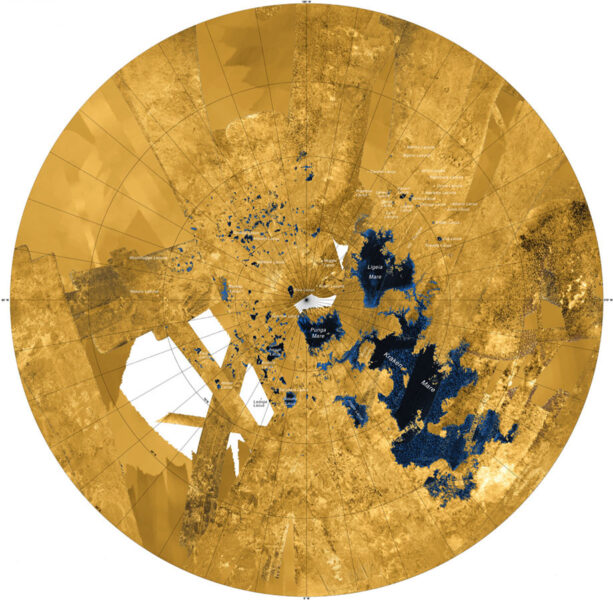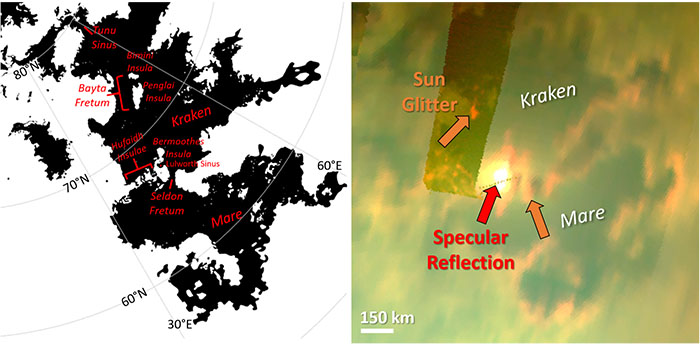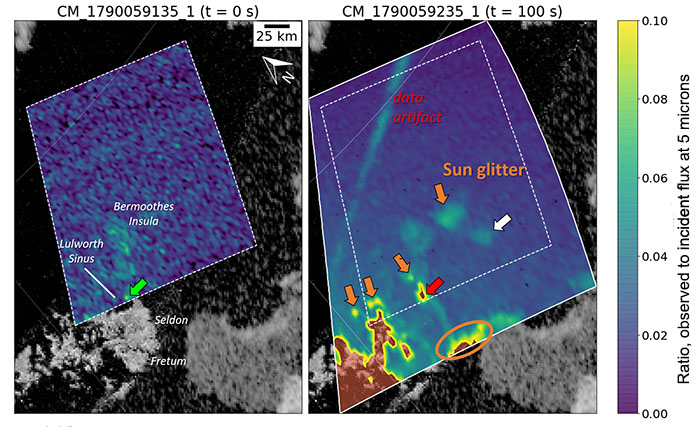Sunlight glittering off rough patches of sea on Saturn’s largest moon indicates ever-changing waves.

NASA / JPL-Caltech / ASI / USGS
The north pole of Saturn’s largest moon, Titan, is a mesmerizing landscape of lakes and seas filled with ethane-tainted liquid methane. Fat methane droplets rain down from the hazy sky, and where rivers flow into sea basins, they may trigger outbursts of nitrogen bubbles. Besides Earth, Titan is the only other world in the solar system with such a dynamic hydrologic cycle on its surface.
The Cassini spacecraft found this wet landscape during its early flybys of Titan as it explored the Saturn system between 2004 and 2017. Blinding glares of sunlight off the lakes and seas confirmed they were smooth liquid bodies. In early years scientists saw no signs of waves, but calculations suggested that winds would rise as the northern hemisphere entered spring in the 2010s and surface temperatures increased slightly, enough to generate tiny waves. Subsequent observations found signs of a few, isolated instances of potential waves in two seas, including so-called magic islands in Ligeia Mare.
Michael Heslar (University of Idaho) and colleagues have now dived into Cassini’s data and found evidence of widespread wave activity on Titan’s largest sea, Kraken Mare. Kraken Mare sprawls over some 1,000 km, roughly the size of the Caspian Sea, Earth’s largest inland body of water.
The team took advantage of high-resolution infrared observations gathered in Cassini’s later Titan flybys to look for sun glitter. Sun glitter is created when sunlight reflects off rougher seas and is weaker than the glare of more direct reflection. Combining imaging and spectral data with radar surface maps, the team found several instances of sun glitter on Kraken Mare’s surface, especially in and around two narrow straits, Bayta Fretum and Seldon Fretum. The sun glitter may indicate consistently agitated seas in the straits — unsurprising for coastal areas, the team notes in the September Planetary Science Journal.

M. F. Heslar et al. / Planetary Science Journal 2020
The sun glitter patterns in Bayta Fretum suggest the waves there are varied, with a range of heights and causes. A combination of tides or sea-breeze-triggered swells moving over shoals may be at root.
Seldon Fretum connects the north and south basins of Kraken Mare and is similar in dimensions to the Strait of Gibraltar between the Mediterranean and the Atlantic. Scientists had expected choppy seas here, because the strait would constrict tidal currents created by Saturn’s pull on the moon. And indeed, the sun glitter stops right outside Seldon Fretum’s north edge, indicating the sea roughness is confined to the strait.
The team also found instances of sun glitter in the nearby archipelago, including the mouth of a cove and off the coasts of Hufaidh Insulae and Bermoothes Insula. These could be due to a buildup of waves near the islands’ coastlines. An additional patch of sun glitter out far away from the islands could be due to a submerged seamount, the team speculates.
“I was excited to see this analysis come out, as the straits of Kraken are where we thought we should see this kind of wind-driven wave activity” says planetary geologist Ellen Stofan (Smithsonian National Air and Space Museum). “I think their evidence is strong.”
Elizabeth Turtle (Johns Hopkins University Applied Physics Laboratory), principal investigator of NASA’s upcoming Dragonfly mission to Titan, concurs. “They’ve done a really thorough job of looking at all the different observations of the reflections, but also interpreting it in the context of the local geology as we understand it.”

M. F. Heslar et al. / Planetary Science Journal 2020
It’s unclear how tall the waves are. Calculations and lab experiments both suggest that waves up to 20 cm high are possible on Titan — hardly a surfer’s dream. Out at Saturn’s distance from the Sun, there’s minimal sunlight reaching sea surfaces through the moon’s thick atmosphere, so winds won’t rise much beyond the speed needed to generate shallow waves, says Heslar. “The typical sunny, sort of ‘fair-weather day’ on Titan just isn’t very conducive for wind activity.”
Furthermore, the tides should be weak, and even in constricted places like the straits, tidal currents won’t get too rough. Given those conditions, the waves probably have centimeter-scale heights. But it’s hard to tell without better knowledge of the seafloors.
Hufaidh Insulae and Bermoothes Insula may be similar to the Torres Strait between Australia and Papua New Guinea, or the Åland Islands in the Baltic Sea, the team suggests. The Torres Strait has some of the most complex tidal circulation patterns on Earth, which combined with the shallow seafloor there gives rise to a variety of waves among submerged sandbars. Conversely, the Åland region has choppy seas swirling around its cliffs and flooded coastlines, and Titan’s islands may similarly be bits of ancient crust submerged by sea level rise, Heslar says.
Studying Titan’s seas gives scientists a unique chance to practice alien oceanography and compare the results to what we see on Earth. Do currents behave the same way in a mixed methane and ethane sea as they do in water? Does the seabed influence waves the way we expect? These are things we won’t know until we return to Titan’s north pole.
Reference: M. F. Heslar et al. “Tidal Currents Detected in Kraken Mare Straits from Cassini VIMS Sun Glitter Observations.” Planetary Science Journal. September 2020 (published online August 14, 2020).
 4
4








Comments
Thomas Aquinas
August 19, 2020 at 5:19 am
In regard to the manner of the Titan Dragonfly mission landing, I question the 2nd parachute and the manner of touchdown. If the canopy of the 1st parachute is the proper one for descent, a 2nd one seems a waste of precious payload. Moreover, on a body with a helpful thick atmosphere and low gravity, touching down makes much more sense than deploying the helicopter en route. Such a system adds an unnecessary additional risk to the mission. Titan is very welcoming to a traditional lander. Let the drone be tested safely on the ground. While we're at it, the removed 2nd chute may allow for more battery or other energy sources.
You must be logged in to post a comment.
Yaron Sheffer
August 24, 2020 at 10:24 am
When the time comes for my dream surfing vacation on Titan, the 8-inch wave height would rank pretty low on the list of items to take care of. The lack of any atmospheric oxygen, plus the ambient temp of -290 F would definitely dominate the top of the list! 😉
You must be logged in to post a comment.
Henry Spencer
September 3, 2020 at 1:52 am
Somebody let their spell-checker get overenthusiastic. A narrow connection between two bodies of water (okay, of liquid) is a "strait", not a "straight"! 🙂
You must be logged in to post a comment.
Camille M. CarlislePost Author
September 3, 2020 at 8:39 am
Well that's embarrassing! Clearly my typing fingers need a vacation. 🙂
You must be logged in to post a comment.
You must be logged in to post a comment.